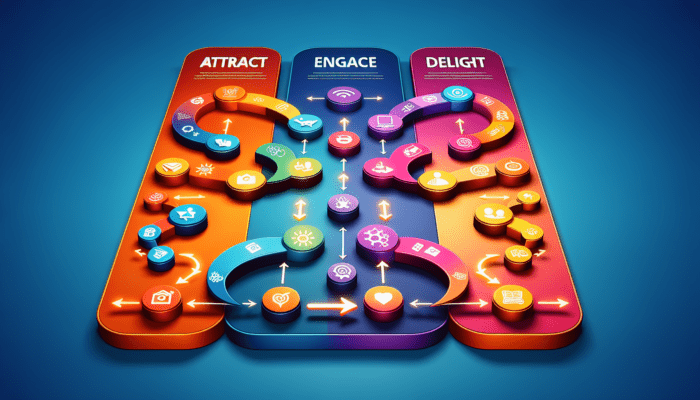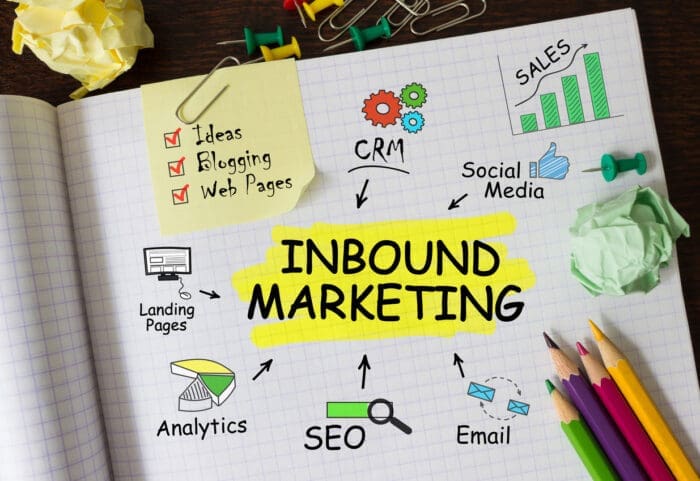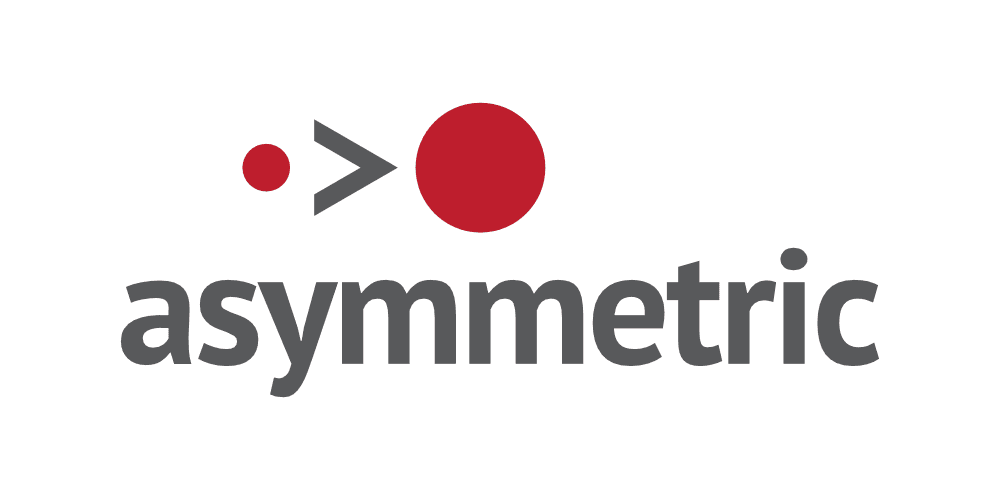Inbound marketing helps attract customers by creating valuable content that addresses their interests. Unlike outbound marketing, which pushes messages to a wide audience, inbound marketing pulls people in naturally. This article will guide you through the best strategies and practices to make your inbound marketing efforts successful.
Key Takeaways
- Inbound marketing focuses on attracting customers through valuable content rather than traditional outbound methods. It emphasizes attracting, engaging, and delighting to enhance customer relationships and retention.
- Successful inbound marketing strategies incorporate effective content creation, engagement tactics, and tools like CRM and marketing automation to streamline processes and improve audience targeting.
- Integrating inbound marketing with outbound strategies can enhance overall effectiveness, ensuring robust audience segmentation and improved personalization of marketing efforts for better lead generation.
Marketing Inbound: Top Strategies & Best Practices

Inbound marketing is a powerful approach that emphasizes attracting customers through valuable content. It contrasts sharply with traditional outbound strategies that push messages to a broad audience. The three key phases of inbound marketing methodology—attract, engage, and delight—are designed to generate leads, increase sales, and improve customer retention.
Combining these strategies with outbound methods enhances audience engagement and brand visibility, resulting in a more comprehensive and effective marketing approach. This synergy between inbound and outbound marketing ensures that while you attract customers with relevant content, you also reach out to potential leads through targeted advertising, making your marketing efforts more robust and impactful.
Introduction
Inbound marketing thrives on creating relevant content that addresses potential customers' pain points. Understanding the customer journey helps identify effective ways to attract and engage individuals. A well-mapped customer journey outlines various touchpoints where inbound marketing can significantly impact.
This blog post will guide you through effective strategies and best practices to enhance your inbound marketing efforts, ensuring you can consistently attract, engage, and delight your audience.
Understanding Inbound Marketing

Inbound marketing is a digital strategy focusing on attracting customers through valuable content tailored to their interests. Unlike outbound marketing, which often interrupts consumers with ads, inbound marketing emphasizes building strong customer relationships by providing relevant, engaging content.
This approach enhances customer engagement and builds trust and loyalty, making inbound marketing a crucial component of any modern marketing strategy.
What is Inbound Marketing?
Inbound marketing attracts customers through valuable content and tailored experiences that address their needs and interests. This concept emphasizes the significance of this approach and the effectiveness of inbound marketing tactics and methodology.
The Flywheel model, a core concept in inbound marketing, emphasizes the stages of:
- Attract
- Convert
- Delight
- Engage
This creates a continuous cycle of customer engagement and satisfaction.
Unlike outbound marketing, which relies on methods like billboards and cold calling, inbound marketing focuses on drawing audiences in with content that answers their questions and solves their problems.
The effectiveness of inbound marketing lies in its ability to build strong customer relationships through trust and value. Solutions to potential customers’ problems generate repeat traffic and increase conversion rates.
This strategy fosters deeper connections with the audience, enhancing brand perception and driving long-term success.
Importance of Inbound Marketing
The primary goal of inbound marketing is to enhance brand awareness and build long-term relationships with customers rather than simply driving immediate sales.
In a world where consumers are bombarded with disruptive ads, inbound marketing offers content that directly appeals to their interests, making it a preferred strategy for many businesses. This approach creates a self-sustaining loop, attracting new prospects through the success and satisfaction of existing customers.
Understanding your target audience is essential for establishing an effective inbound marketing strategy. Methods such as analyzing CRM data, conducting surveys, and researching social media can provide valuable insights into customer behavior and preferences.
Consistently creating quality content that aligns with your audience’s interests increases the chances of attracting and retaining potential customers.
Key Components of an Inbound Marketing Strategy

An effective inbound marketing strategy involves three main components: attracting your target audience, engaging your prospects, and delighting your customers. Leveraging a multichannel approach, including SEO, content marketing, and social media, is crucial for maintaining consistent communication and engagement with your audience.
Additionally, utilizing various tools to support content creation, analytics, and customer engagement can significantly enhance your inbound marketing efforts.
Attracting Your Target Audience
Attracting potential customers is the first step in a successful inbound marketing strategy. This can be achieved through fundamental approaches such as:
- SEO, which improves content visibility on search engines, helping your audience find you when they search for relevant topics
- Content marketing, which involves creating and distributing valuable content that addresses your audience’s needs and interests, drawing them to your brand
- Social media amplifies your content reach and increases visibility, making them essential for the attract stage.
Companies like Moz effectively attract users by offering free tools and detailed SEO guides that help improve search engine rankings. Buffer also utilizes a variety of social media content formats to engage with its users, showcasing the power of diverse content in attracting an audience.
Segmenting your content plan into manageable topics can help you target your audience’s search intents more effectively, ensuring that your content resonates with their needs.
Engaging Your Prospects
Engaging your prospects involves nurturing leads through personalized content and interactive tools. Quality content is essential in this stage, as it directly correlates to customer engagement and brand loyalty.
Interactive tools, such as quizzes and calculators, can enhance engagement by providing value and entertainment to potential customers. CRM systems play a significant role in this process by providing essential information for improved client interactions, helping to tailor your engagement strategies effectively.
Metrics such as dwell time and social media interactions provide insights into the effectiveness of your engagement efforts. Buffer has cultivated a community of marketers by actively engaging on social media and providing valuable content.
Their transparency in operations further enhances trust and loyalty among users, demonstrating the importance of honest and open communication in engaging prospects.
Delighting Your Customers
Delighting your customers is the final stage of the inbound marketing strategy, focusing on enhancing customer satisfaction and engagement. Effective strategies for delighting customers include thoughtful chatbots, satisfaction surveys, and engaging content.
Social media can be used to respond to customer inquiries and share product updates. It also provides valuable information, which helps to strengthen customer relations.
Email marketing plays a crucial role in the delight stage by assisting with onboarding processes and delivering valuable insights to customers. Satisfaction surveys gather feedback and ideas for improvement post-purchase, helping to enhance customer relations and drive continuous improvement.
Social media listening is another vital tool. It allows businesses to understand and respond effectively to customer feedback, ensuring high customer satisfaction.
Effective Tactics for Inbound Marketing Success

Implementing well-planned tactics can significantly enhance the effectiveness of inbound marketing efforts. By integrating inbound marketing strategies with marketing automation, businesses can move leads through the purchase pipeline more efficiently, ensuring a seamless and effective marketing process.
Content Creation and Distribution
Content creation is at the heart of inbound marketing. High-quality, valuable content that aligns with audience interests is crucial for driving engagement and loyalty.
Developing an editorial calendar helps ensure consistent content creation and sharing while promoting content through SEO, social media, and email newsletters, which increases its reach and impact. It’s important to avoid being overly sales-oriented in your content, focusing instead on providing value and addressing audience needs.
A successful content plan prioritizes high-volume search terms relevant to your audience’s needs, ensuring your content is discoverable and engaging.
Tailoring content to different stages of the buyer’s journey helps engage various audience segments, providing them with the information they need at each step. This approach attracts and nurtures potential customers through the sales funnel, ultimately driving conversions and loyalty.
Leveraging Social Media Channels
Social media channels amplify content reach and foster real-time engagement with your target audience.
consistent social media presence enhances brand visibility and facilitates interactions with followers, helping to build relationships and trust. Exceptional customer service on social media can turn satisfied customers into brand advocates, further amplifying your reach and impact.
Using social media management tools helps plan and schedule posts, providing analytics for performance improvement. These tools allow you to monitor engagement metrics and adjust your social media strategies based on data, ensuring that your efforts are effective and aligned with audience preferences.
By actively engaging with your audience on social media, you can foster a community of loyal followers who are more likely to engage with and promote your brand.
Utilizing Email Marketing
Email marketing is essential for nurturing relationships and sharing content with leads. It provides a direct and personal way to communicate with your audience.
Email marketing software can manage subscriber lists, design newsletters, and automate marketing efforts, ensuring that your campaigns are efficient and effective. A well-maintained customer relationship management (CRM) system enhances email marketing efforts by turning inbound leads into marketing contacts and enabling better nurturing.
Targeted email communication helps maintain customer relationships by delivering personalized content that addresses their needs and interests. By segmenting your email lists and tailoring your messages, you can provide relevant information and offers to different audience segments, increasing engagement and conversion rates.
Regularly analyzing email performance metrics allows you to refine your strategies and optimize your campaigns for better results.
Tools and Technologies for Inbound Marketing
Effective inbound marketing relies on various tools and technologies to streamline processes and enhance performance. CRM software, analytics tools, and marketing automation platforms are essential for managing leads, tracking customer interactions, and measuring campaign success.
Integrating these tools ensures a cohesive and efficient inbound marketing strategy, optimizing your efforts across multiple channels.
CRM Software
CRM software is pivotal for tracking leads and automating marketing processes, serving as the backbone of effective inbound marketing. By aligning marketing and sales teams, a CRM ensures that both departments work towards common goals based on collected data.
Tools like Nutshell are highly recommended for inbound marketing beginners because of their comprehensive features and ease of use.
Analytics Tools
Analytics tools are indispensable for tracking and analyzing the success of inbound marketing campaigns. Tools like Google Analytics and CRM systems offer valuable insights into user behavior, enabling marketers to measure key performance indicators such as website traffic, search rankings, and conversion rates. These insights are crucial for refining strategies and optimizing marketing efforts.
Understanding content performance and audience interaction patterns on social media can also be enhanced through specific analytics tools. Leveraging these tools gives businesses a comprehensive view of their inbound marketing performance, enabling informed decisions to improve their overall strategy.
Marketing Automation
Marketing automation streamlines inbound marketing processes, making managing and executing multichannel campaigns easier. This technology bridges the gap between engagement and conversion, enhancing the efficiency of your inbound marketing efforts. Automation platforms help manage diverse marketing tasks, from email campaigns to social media posts, ensuring consistent communication with your audience.
Integrating marketing automation with other tools, such as CRM and analytics, can significantly boost the effectiveness of your inbound strategy. This integration allows for better lead management, personalized content delivery, and improved overall campaign performance, making marketing automation a critical component of successful inbound marketing.
Measuring the Success of Inbound Marketing Efforts
Measuring the success of inbound marketing efforts is crucial for continuous improvement and optimization. By setting clear goals, analyzing key metrics, and adjusting strategies based on data, businesses can ensure that their inbound marketing strategies are effective and aligned with their objectives.
This data-driven approach allows for more informed decision-making and better overall performance.
Setting Clear Goals
Establishing specific, measurable, attainable, relevant, and time-bound (SMART) goals is essential for guiding inbound marketing efforts. These goals help select appropriate metrics and ensure effective measurement of marketing performance.
Key performance indicators (KPIs) such as organic website traffic and conversion rates are critical for assessing the impact of inbound marketing campaigns.
Analyzing Key Metrics
Tracking key performance metrics such as website traffic, lead generation, and search rankings is vital to evaluating the effectiveness of inbound marketing. Tools like Google Analytics, Google Search Console, and social media analytics provide essential insights into these metrics, allowing businesses to measure progress effectively. Companies can demonstrate the success of their inbound marketing efforts through measurable growth metrics.
Digital channels facilitate tracking results, making metrics measurement easier and more accurate. Regular analysis of these metrics allows businesses to assess the impact of their inbound marketing campaigns and make data-driven adjustments to optimize strategies.
Adjusting Strategies Based on Data
Leveraging data insights to refine marketing tactics ensures that strategies are optimized for maximum effectiveness. Analyzing performance data helps marketers identify areas for improvement and adjust techniques to enhance overall campaign outcomes. This continuous process of assessment and adjustment is key to maintaining successful inbound marketing efforts.
Regularly reviewing and adjusting strategies based on data gathered from inbound marketing campaigns allows businesses to stay agile and responsive to changing market conditions. This approach improves the efficiency of marketing efforts and ensures that they remain aligned with business goals and customer needs.
Real-World Examples of Successful Inbound Marketing

Examining real-world examples of successful inbound marketing can provide valuable insights into how these strategies work. By analyzing the approaches of leading companies, businesses can learn how to apply similar tactics to enhance their inbound marketing efforts.
Example 1: HubSpot's Blog and Resource Center
HubSpot effectively utilizes educational content to attract and engage its target audience. By providing valuable resources and educational materials, HubSpot draws in potential customers who seek knowledge in the marketing industry. This approach inspires customer engagement and builds recurring relationships with users who seek continuous learning.
Using educational content in inbound marketing leads to deeper connections and trust among the audience.
Example 2: Moz's SEO Guides and Community Engagement
Moz’s approach to inbound marketing centers around providing detailed SEO guides and fostering community engagement. By offering valuable resources and encouraging knowledge sharing among users, Moz creates a collaborative environment that enhances customer engagement and loyalty.
This strategy helps users improve their online visibility and positions Moz as a trusted authority in the SEO industry.
Example 3: Buffer's Social Media Content and Transparency
Buffer emphasizes transparency in its operations, cultivating trust with its audience. By being open about its processes and sharing valuable social media content, Buffer builds a loyal community of followers who appreciate its honesty and engagement. This transparent approach enhances customer relationships and sets Buffer apart as a trustworthy and reliable brand in the digital marketing space.
How Inbound Marketing Integrates with Other Marketing Tactics
Inbound marketing works best when integrated with other marketing tactics, creating a comprehensive and effective strategy. Combining inbound and outbound marketing enhances audience segmentation and improves targeting and personalization.
This synergy ensures that marketing efforts are more robust and impactful, driving better results.
Combining Inbound and Outbound Marketing
Integrating inbound marketing with outbound and inbound marketing methods allows for better audience segmentation and personalization. Both strategies enhance lead generation by effectively guiding potential customers through the marketing funnel.
This combined approach ensures that while inbound marketing attracts and nurtures leads, outbound marketing reaches out to potential customers, creating a well-rounded strategy.
Inbound Marketing and Account-Based Marketing
Inbound marketing can significantly enhance account-based marketing (ABM) efforts by providing insights into customer behavior through content interactions. ABM focuses on specific customers with personalized experiences; inbound marketing supports this by delivering tailored content and engagement.
This integration ensures that marketing efforts are highly targeted and effective, driving better results for B2B strategies.
Getting Started with Your Inbound Marketing Strategy
Launching an effective inbound marketing strategy involves setting clear objectives, understanding your audience, and developing a consistent content plan. Utilizing the right tools and software is crucial for successfully implementing and monitoring your strategy.
This section will provide a step-by-step guide to help you get started with your inbound marketing efforts.
Defining Your Target Audience
Understanding your target audience and their needs is critical for developing a strong inbound marketing strategy. Conducting interviews with decision-makers and creating detailed customer personas can provide valuable insights into audience values and challenges.
This foundational step ensures your content and marketing efforts are tailored to your potential customer's needs and interests.
Creating a Content Plan
A well-structured content plan should align with the interests of your target audience and guide them through their buying journey. Content should cater to different stages of the buyer’s journey, providing valuable information and solutions that engage various audience segments.
You can effectively attract and nurture leads by creating a diverse range of content that addresses your audience’s needs.
Implementing and Monitoring Your Strategy
Implementing your inbound marketing strategy involves utilizing the right tools and consistently executing your content plan. Regularly monitoring the performance of your marketing efforts is essential for making necessary adjustments and improvements. Analytics tools and CRM systems can provide valuable insights into the effectiveness of your strategy, helping you refine your tactics for better results.
Regular assessment and adjustment of your inbound marketing strategy ensure that you remain agile and responsive to changing market conditions. Continuously optimizing efforts based on data insights enhances the efficiency and impact of marketing campaigns, driving long-term success.
Summary
Inbound marketing is a powerful approach focusing on attracting, engaging, and delighting customers through valuable content. Understanding your audience, creating a consistent content plan, and leveraging the right tools and technologies can enhance your inbound marketing efforts and drive sustainable growth.
Regularly measuring and adjusting your strategies based on data insights ensures that your marketing efforts remain effective and aligned with your business goals. Start implementing these best practices today to build strong customer relationships and achieve long-term success.

Frequently Asked Questions - Inbound Marketing
What is inbound marketing?
Inbound marketing is a strategy that aims to attract customers by providing valuable content and personalized experiences. This approach fosters engagement and builds lasting relationships with the target audience, in stark contrast to traditional outbound marketing, which disseminates messages broadly.
Why is inbound marketing important?
Inbound marketing is important because it enhances brand awareness and fosters long-term customer relationships. This creates a self-sustaining cycle that continuously attracts new prospects through existing customer success.
How can CRM software help in inbound marketing?
CRM software enhances inbound marketing by effectively tracking leads and automating marketing processes, which fosters alignment between marketing and sales teams. This ensures that both departments operate towards common objectives informed by data-driven insights.
What are some key metrics to measure inbound marketing success?
To effectively measure inbound marketing success, focus on key metrics such as website traffic, lead generation, search rankings, and conversion rates. Utilizing tools like Google Analytics and CRM systems can provide vital insights into these areas.
How can inbound marketing be integrated with other marketing tactics?
Integrating inbound marketing with outbound methods improves audience segmentation and personalization. Leveraging insights from content interactions can also enhance account-based marketing strategies.

Unlock the Power of Inbound Marketing Today
Ready to transform your business with inbound marketing?
Whether you're looking to attract more leads, nurture stronger customer relationships, or scale your marketing efforts, we’re here to help.
📈 Get Expert Guidance
Our team of inbound marketing specialists at Asymmetric Marketing is ready to tailor strategies to your unique business needs.
We have the tools and expertise to drive real results from content creation to lead nurturing.
Let’s Grow Together!
- Contact Us Today to discuss your inbound marketing strategy.
- Schedule a Free Consultation with one of our marketing experts.
- Explore Our Inbound Marketing Services and see how we can help you succeed.
Don't wait—take the first step toward growing your business with effective inbound marketing!
About the author
Mark A. Hope is the co-founder and Partner at Asymmetric Marketing, an innovative agency dedicated to creating high-performance sales and marketing systems, campaigns, processes, and strategies tailored for small businesses. With extensive experience spanning various industries, Asymmetric Marketing excels in delivering customized solutions that drive growth and success. If you’re looking to implement the strategies discussed in this article or need expert guidance on enhancing your marketing efforts, Mark is here to help. Contact him at 608-410-4450 or via email at mark.hope@asymmetric.pro.

